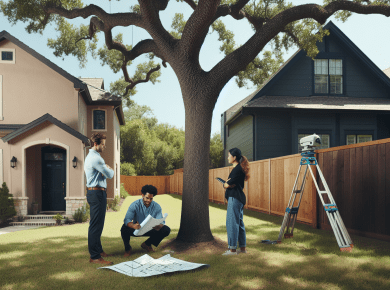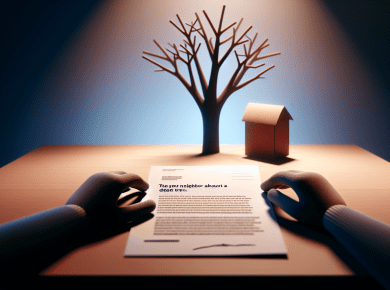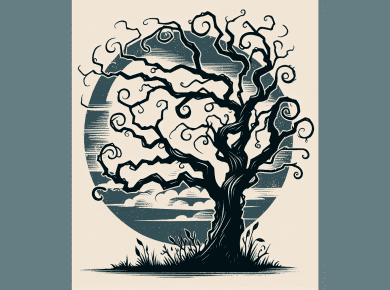Table of Contents
- A neighbor cut down my tree in New York
- My neighbor cut my tree in New York
- My tree branches overhang my property in New York
- My neighbor damaged my tree on my property in New York
- My neighbor’s tree roots or branches damaged my property in New York
- Can my neighbor make me cut my tree?
- How can I get my neighbor to cut his dead tree in New York?
- What happens if I cut my neighbor’s tree down in New York?
- If a tree is cut down on my property by a neighbor how much money should I receive in damages?
- If your property was damaged click here to see if you might have a case.
In New York, a property owner has the right to cut tree branches that extend onto his or her property. A property owner also has a common-law obligation to protect other property owners from imminent harm from trees and branches on his or her property.
However, it is illegal for a person to cut down a neighbor’s tree unless they have permission from the tree owner. If your neighbor cuts down a tree without permission, he or she may be liable to you for damages. However, you must prove that your neighbor maliciously damaged your property in order to recover damages.
A neighbor cut down my tree in New York
If you’ve had a neighbor cut down your tree in New York, you have legal recourse to take. It’s important to act as quickly as possible to ensure retribution is had and to make sure your neighbor cannot propose that the tree was already dead or not on your property.
The first step you must take is to gather evidence and prove ownership of the tree. Documentary proof of ownership can include photographs of the tree, along with its location on the property line. You can also collect any debris from its removal, such as branches, leaves or even sawdust. The more evidence you have to prove ownership, the better.
Once you have gathered evidence, contact the NYPD directly to report the incident. The police should come and inspect the property to make sure all items have been removed and to officially file a report. It’s important to stay at the property in question until the police arrive, or at least assign someone on your behalf to stay at the property.
Once the police report is filed, you should consult with a lawyer who practices in property related cases in New York. A lawyer like this will help you prepare a valid case against your neighbor and will be able to file any necessary further documentation in order to take legal action against them. At USAttorneys.com, we can connect with you a property lawyer in your area of New York that is well versed in these types of cases.
If your neighbor is found guilty, a judge may bring forward a punitive damages claim, or in rare cases, a criminal charge may be issued. It’s important to take legal action when necessary, as it can help ensure no one else suffers from a similar experience.
My neighbor cut my tree in New York
Cutting a tree down, even if it’s on your own personal property, is illegal in New York, there are certain steps you should take to rectify the situation.
First, you should take a photo of the stump and the property line so you have evidence that the tree is yours. Then, you should file a complaint with the City of New York. Provide a copy of the photo along with your complaint as an attachment.
Next, contact an arborist or a tree company to give you a free estimation on what it will cost to replace your tree. You will most likely want to make a claim for the loss of your tree against your neighbor’s homeowners insurance as part of the settlement.
You can also take your neighbor to civil court to recover financial compensation for the cutting of your tree. Contact an experienced attorney to determine if you have a strong case. If so, then you can file a lawsuit and make a claim for financial damages.
Ultimately, it is important to remain calm and avoid engaging in conversations or arguments with the neighbor who cut your tree. Make sure to document the situation and follow the steps above to seek a fair resolution.
My tree branches overhang my property in New York
If your tree branches are overhanging your property in New York, you should be aware of the regulations and laws that govern tree branches in this state.
The first step is understanding your rights and responsibilities as a tree owner. In general, a person has the right to trim or remove tree branches that are overhanging their property, provided that they do not cause material injury or damage to their neighbor’s property. For this reason, it is important to trim any overhanging branches back to the property line with consideration for the neighboring property.
However, it is important to remember that even though you are legally allowed to trim branches that are overhanging on your own property, you may still be responsible for damages or injuries caused by your trimming. Tree removal is best left to a professional and such a professional will follow State regulations and laws to ensure legally permissible tree trimming. Some of the laws and regulations that need to be followed in New York include the New York City Tree Care Business Licensing Law and the Department of Environmental Conservation’s forestry guidelines.
Additionally, you may need to get approval from your local municipality before removing an overhanging tree branch. It is also possible for a tree owner to be sued for negligence or interference with their neighbor’s property if they trim or remove a tree branch without considering the neighbor’s interests. Lastly, even if your trees are on your own property, they may be subject to the regulations of the municipality or county, depending on the jurisdiction.
In conclusion, it is important to work in conjunction with your neighbors to mutually trim any overhanging branches. It is also important to ensure you are following all legal guidelines and regulations before trimming or removing branches from your own property.
My neighbor damaged my tree on my property in New York
My Neighbor Damaged My Tree on My Property in New York
In the state of New York, it is illegal to damage another person’s property without their permission. This includes trees that are on your property. If your neighbor has damaged your tree, then you are legally entitled to seek recourse to repair or replace the tree. Here is a guide to help you with this process.
1. Document the incident. Take pictures and video of the damage and the tree, if possible. Save any communication between your neighbor and yourself regarding the incident.
2. File a complaint with the local police department. Even if the damage is minor, it is important to document it and make sure that it is officially recorded.
3. Contact your neighbor and try to resolve the issue amicably. Explain to them that the tree is your property and it is illegal for them to damage it without your permission.
4. Determine what kind of property damage occurred. If it is minor, then you may decide not to pursue a legal remedy. If the damage is significant, then you must decide if you want to pursue a suit against your neighbor or simply seek compensation for the damage.
5. File a claim with your home insurance provider. Depending on the circumstances, your insurance provider may reimburse you for the damage.
6. Consult an attorney. If the damage is significant and you decide to pursue legal recourse, then consulting an attorney is your best option. They can help you determine your legal rights and the best way to seek justice.
In the state of New York, it is illegal to damage another person’s property without their permission. If your neighbor has damaged your tree, being aware that it is your right to pursue legal action to repair or replace the damage. Please follow these steps to ensure that you are properly able to get compensation for the damage.
My neighbor’s tree roots or branches damaged my property in New York
If your neighbor’s tree roots or branches have damaged your property in New York, there are steps you can take to resolve the issue.
First, you should contact your neighbor to discuss the situation and attempt to negotiate a solution. Examine the rules governing this issue in your community, as they differ from town to town in New York. You may have a legal right to compensation, depending on what rights your town grants you.
Next, it’s important to document the damage to your property. Take pictures, videos, and keep receipts of any expenses related to the damage caused by your neighbor’s tree. If a tree limb damaged your roof, keep the broken portion of it for evidence as well.
If you cannot achieve a satisfactory resolution with your neighbor, it could be necessary to contact a mediator, or if the situation is serious enough, speak with a lawyer. Your legal rights depend on the laws governing trees in your community, so make sure you’re familiar with the laws that apply in your area.
If a court hearing is necessary, the judge will assess the evidence and the impact of the damage to determine if compensation is due. New York law allows you to recover substantial damages from a negligent neighbor, so you may receive financial compensation.
No matter what initially caused the tree damage, it’s important to determine the best way to resolve it. With the right preparation and understanding of the law, a neighbor’s tree roots or branches can be dealt with in New York.
Can my neighbor make me cut my tree?
When it comes to trees, disputes between neighbors can arise, with one neighbor wanting the other to cut their trees down. In these situations, it’s important to know your rights.
If your tree is causing damage to your neighbor’s property or blocking their view or sunlight, they may request you to trim or prune back the branches causing the problem. However, the neighbor cannot force you to do anything and you have the right to appeal any decision to have your trees cut down.
When confronting the neighbor, it’s important to keep the conversation civil and be willing to compromise. After understanding the underlying cause for the dispute, discuss potential solutions such as pruning the tree, removing any fallen branches on the property, or hiring an arborist to assess the damage.
You can also check your local tree laws to determine whether your tree fallen in a protected area or is designated as public property. The laws may give you certain rights over about how much you must prune or when and if you need to remove the tree.
Alternatively, it’s also a good idea to get a third-party opinion such as an arborist or landscape architect. They will be able to check if the tree is healthy, how tall it is, and how much it’s blocking the neighbor’s view. This can potentially help resolve the conflict and make sure it is being handled in a fair and reasonable way.
In the end, it’s important to remember to remain respectful during the process and to be open to negotiating if any conflicts arise. By pursuing a resolution peacefully and in accordance with local laws, a satisfactory conclusion to the dispute can hopefully be reached for both parties.
How can I get my neighbor to cut his dead tree in New York?
- Begin by considering why it’s important to get your neighbor to cut the dead tree. Dead trees represent a dangerous hazard and can fall on people and property during a storm or high winds. Following safety considerations, following the tree across property lines, and dealing with the noise alone should be enough for your neighbor to take action.
- Research and figure out which regulation applies to the removal of the tree in your area. Some local municipalities have specific rules that govern tree removal and provide direction on who is responsible and how it can be done.
- Reach out to your neighbor in a friendly and non-threatening way. Speak with your neighbor and provide the facts and information you gathered. Explain the safety risks posed by the tree and how it could damage property and endanger people. Suggest that it would be great if they could take care of it right away.
- If your neighbor is not willing to take action, suggest alternatives such as expert consultation or paying for a tree service professional to do the work. This will prove that you are simply looking out for the safety of everyone and trying to be a good neighbor.
- If your neighbor still refuses to take action, you can try contacting your local municipality. Depending on the area, some localities will intervene and require a dead tree to be removed.
Dead trees pose a very real safety and health risk to both people and property, and taking the necessary steps to remove them is important. Following these steps should get you and your neighbor on the same page and make tree removal a priority.
What happens if I cut my neighbor’s tree down in New York?
If you cut down your neighbor’s tree in New York, there are a few key steps you need to be aware of.
First, you need to determine who owns the tree. If it is on your property, or both parties have agreed to you cutting it down, then there isn’t a legal issue. If it is your neighbor’s tree and they did not agree to you cutting it down, then you may be liable for damages.
Second, you need to be aware of the laws in New York. Under the Urban Forest Law, it is illegal to remove, damage, or injure a tree on public land without getting a permit from the appropriate government agency. It is also illegal to damage, remove, or injure a tree on private property without the property owner’s permission. If someone is found guilty of either, the court may impose heavy fines or an injunction ordering the violator to take measures to restore the tree’s health and habitat.
Third, if you do cut down your neighbor’s tree without their permission, you may be liable for damages. Depending on the circumstances, damages may include the value of the tree, as well as any costs associated with repairing the damage.
Finally, you should also be aware of the consequences for cutting down your neighbor’s tree. Not only could you be liable for damages, but you may also face criminal charges. It is important to understand the law surrounding cutting down a tree on another person’s property, as well as the consequences of taking such actions.
In conclusion, cutting down your neighbor’s tree without their permission could lead to serious consequences. It is therefore important to understand both the laws and potential ramifications before taking any action.
If a tree is cut down on my property by a neighbor how much money should I receive in damages?
New York law directs that a property owner found liable for cutting down a neighbor’s tree is responsible for paying the greater of two things:
1. The fair market value of the tree immediately prior to it being cut down, or
2. 3 times the cost of replacing the tree (including the cost of planting and care).
The better alternative for determining damages is usually 1 – the fair market value of your tree immediately before it was cut down. If you have any receipts from when you have had your trees professionally trimmed or pruned, those will be helpful in establishing the value. Otherwise, if you can find a local arborist to come out and look at the stump and tell you what he or she would have charged to trim that particular species, that should help establish damages as well.
New York Law (Sec. 253-a of the Real Property Actions and Proceedings Law) directs that landowners found liable for cutting down their neighbor’s tree are responsible for paying “the greater of three times the cost of replacing the tree or the fair market value of the tree immediately prior to it being cut down”.



